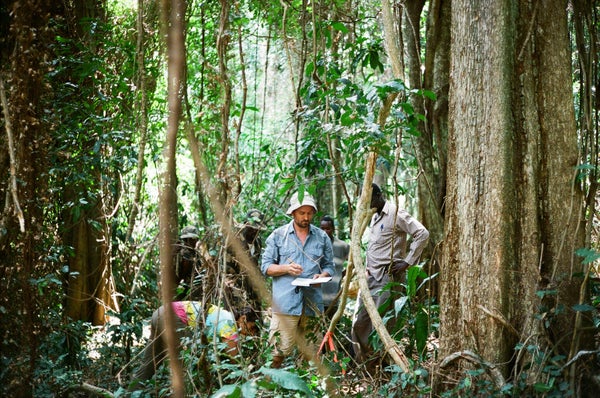Here’s something to think about as you sip that morning mochaccino: Deforestation, climate change and the proliferation of pests and fungal pathogens are putting most of the world’s wild coffee species at risk of extinction.
At least 60 percent of wild coffee species are considered “threatened,” according to a study published this week in Science Advances. And fewer than half of all the wild species are safeguarded in so-called germplasm collections—banks for seed and living plants kept in protected areas as backups.
Wild coffee species are an important source of genetic material for crossbreeding useful traits into commercial crops. A morning cup of domesticated Arabica (Coffea arabica, the species that dominates commercial cultivation) might have been produced with the help of disease-resistance genes from the once-wild robusta (C. canephora), for example. As climate change increasingly drives shifts in local environmental conditions, wild coffee species could be essential to the sustainability of commercial coffee production. “Looking back at the history of coffee cultivation, time and time again, every 40 years or so we have gone back to wild populations to use wild genetic diversity to solve specific production problems,” says Aaron Davis, the study’s lead author and head of coffee research at England’s Royal Botanic Gardens, Kew.
On supporting science journalism
If you're enjoying this article, consider supporting our award-winning journalism by subscribing. By purchasing a subscription you are helping to ensure the future of impactful stories about the discoveries and ideas shaping our world today.
Davis and his colleagues evaluated all 124 known coffee species using the International Union for Conservation of Nature (IUCN) Red List of Threatened Species. They studied wild coffee plants in the field, and identified conservation challenges such as a lack of germplasm collections and human encroachment on protected areas.
.jpg?w=900)
Young Arabica coffee plants, south-west Ethiopia. Credit: Alan Schaller, Union Hand-Roasted Coffee
The researchers then assigned each species to one of three priority groups: Group I comprises the four species predominantly used in commercial production and their wild relatives; wild C. arabica was the only threatened species in this category. Group II encompasses all 38 African coffee species—23 of which are threatened. Group III holds 82 species, 51 of them threatened.
Surveying all coffee species worldwide was no easy task. Davis began collecting survey data in Madagascar in 1997 and has since made 11 coffee expeditions, most recently one in Sierra Leone last December. Just finding the wild plants can be a challenge. In Madagascar Davis had to work in dense tropical rainforest. Finding coffee among thousands of other plants was extremely difficult, he says. A Malagasy botanist showed him the ropes, pointing out things such as bark characteristics that could provide clues. “You have got to look through the forest for a very specific, sort of gestalt, character” to find the wild coffee plants, Davis says.
Coffee species are notoriously difficult to conserve for a variety of reasons, says Sarada Krishnan, director of horticulture and the Center for Global Initiatives at the Denver Botanic Gardens who was not involved in the study. Each species has very specific climate requirements and is highly specialized to tolerate a narrow range of habitat conditions, she notes. Also, whereas the Coffea genus is represented around the globe, each wild species has a very small natural distribution. “With climate change, coffee is going to be one of those genera that is going to be highly impacted because of its limited suitability for wider eco-regions,” Krishnan says. And deforestation poses a particularly acute extinction threat; when “the forest is gone, that species is gone.”
“It’s very difficult to stop deforestation,” says Christophe Montagnon, scientific director of the nonprofit World Coffee Research who did not take part in the work. “We are not sure we can. But what we can do is rush into the forest where we have those endangered species and bring them back to germplasm collections.” World Coffee Research, in partnership with the Global Crop Diversity Trust, aims to raise $25 million to develop a pool of coffee germplasms. “It's very important that we can tap into the reservoir of genes of the genus Coffea to be able to meet the challenges we are facing,” Montagnon says.
Maintaining coffee germplasms in seed banks can be problematic, however. Coffee beans do not easily tolerate the very cool, dry conditions generally required in such facilities. As a result, seed bank collections have to be continually replenished and improved, Davis says. Cryopreservation, or freezing, is a potential approach—but costs can be prohibitive. Ultimately, the study researchers recommend engaging with local farmers to find solutions that can protect biodiversity and maintain farmers’ livelihoods.
Davis and his colleagues have been discussing how to develop cryopreservation capabilities. “We definitely need to do that,” he says, “if we're interested in preserving the wild relatives of many of our tropical crop species.”
